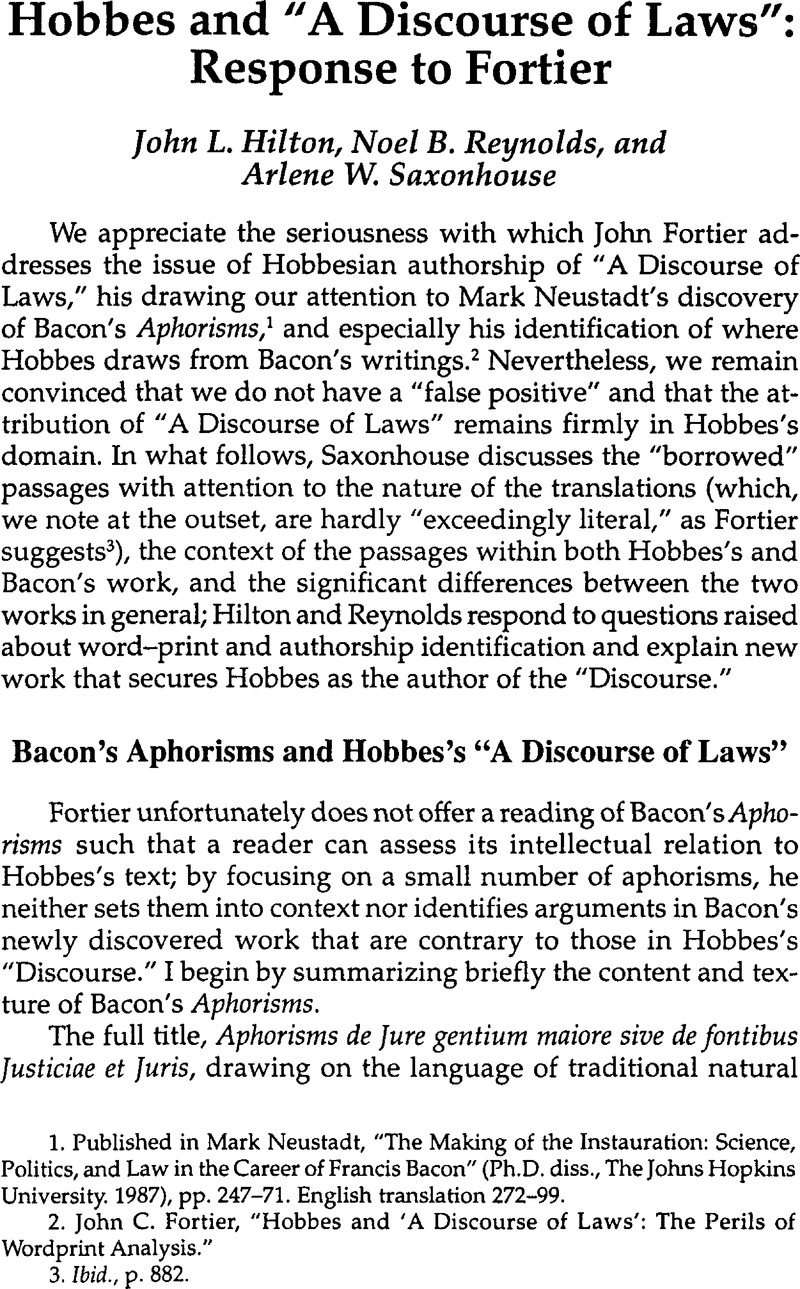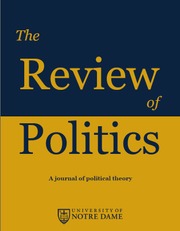Article contents
Hobbes and “A Discourse of Laws”: Response to Fortier
Published online by Cambridge University Press: 05 August 2009
Abstract

- Type
- Discussion
- Information
- Copyright
- Copyright © University of Notre Dame 1997
References
1 Published in Neustadt, Mark, “The Making of the Installation: Science, Politics, and Law in the Career of Francis Bacon” (Ph.D. diss., The Johns Hopkins University. 1987), pp. 247–71Google Scholar. English translation 272–99.
2 John C. Fortier, “Hobbes and 'A Discourse of Laws': The Perils of Wordprint Analysis.”
3 Ibid., p. 882.
4 Page numbers in the text refer to the Aphorisms as they appear in the appendix to Neustadt's thesis (1987). I rely on his translations unless otherwise noted. Fortier's translations, as I will note below, too often follow Hobbes's English rather than Bacon's Latin.
5 Noel B. Reynolds has shown, “Thomas Hobbes's A Discourse of Laws” (Paper delivered at the annual meetings of the American Political Science Association in New York City, 1 September 1995) that there are at least 19 and perhaps 25 borrowings from other sources in the “Discourse.”
6 In text citations of Hobbes's “Discourse” include first the pagination from the original text of the Horae Subsecivae: Observations and Discourses (London: Edward Blount, 1620)Google Scholar, followed by pagination from the current edition of the Three Discourses. Since I quote frequently from the same page, references come at the end of a passage.
7 The order in which the “borrowings” appear is: Aphorism 10, 8, Introduction, 5, 11, 9.
8 Neustadt's translation is inadequate here; he reduces legem in corpore civili to “body politic.”
9 Fortier translates enervatio (Neustadt's “debilitation”) as“dissolution,” as does Hobbes, though the Latin word dissolutio appears a few lines below. Hobbes gives the same translation for two different words. Neustadt tries to preserve the distinction between the two Latin words that Hobbes and, following him, Fortier ignore.
10 Space limitations prevent pointing to the many places where context and translation clarify differences rather than similarities between the two texts. Some, but not all, will be noted below.
11 Fortier translates Bacon's novationes with Hobbes as “introductions,” not as Neustadt, “alterations” (or the dictionary's “renovations”). The implications of each term are different, the latter emphasizing change, the former beginnings.
12 Hobbes considers the “causes” (a word missing in Bacon) for laws. Among them he includes “affectation of popularity.” Bacon had written studio popularitatis. Neustadt correctly translates studio as “eagerness”; Hobbes consciously, we must assume, mistranslates studio as “affectation” (as does Fortier). “Eagerness” and “affectation” are hardly synonyms. (See the essay on“Affectation” included in the Horae.) Further scrutiny reveals the omission of several phrases in Hobbes's borrowing. An example of Hobbes's free translation is where Bacon writes that the laws which grief (dolor) persuades (suadet) are immoderatae, Hobbes writes that laws “forced, out of a sense of mischief and inconviences” are the “grievous and immoderate” ones. Bacon uses only immoderatae. Hobbes frequently finds two adjectives or nouns to replace one in Bacon. In the next phrase, a singular noun (ratio) doubles in Hobbes: “reason and providence.“ Then stimulus becomes “spur and sense of ill”; incautio becomes “careless and unwary”; and the adjective languidos becomes an extended verbal phrase: “faint in the execution” (p. 524/112).
13 As I noted in comments on this discourse in our edition of the Three Discourses, this passage seems peculiarly out of place (Saxonhouse, et al. , Three Discourses [Chicago: University of Chicago Press, 1995], p. 152Google Scholar). That this is borrowed from Bacon may explain its awkwardness.
14 In this borrowing, patterns of expansion and change in Hobbes's rendering continue: “justice and equity” are general for all laws in Hobbes; Bacon limits the discussion to civil laws. Bacon's civil laws are infected with naturalem aequitatem Hobbes leaves it as “Laws and the virtue of them.” When Bacon introduces his image of veins of water, Hobbes adds “currents”; likewise, Bacon's soli becomes “ground and soil.” Bacon's prudentia becomes “virtue” with the addition “which be fetched from the original fountain.” Consistently, the additional words create patterns which are among the tests used for wordprint analysis.
Fortier ends Exhibit 3 before Hobbes has finished the sentence in which he writes: there are “sundry other occurrences that give a tincture” to the laws, but he “will not stand to repeat.” Hobbes's paragraph ends by turning to “wise men” (p. 525/113); Bacon continues his Introduction by commenting on the novelty of the Aphorisms that are to follow (p. 248).
15 In this borrowing Hobbes again doubles a single noun (“change and variation” for mutationes) and for Bacon's reference to “foreign customs” and “internal causes,” Hobbes writes of “entertaining foreign customs” and of “internal deficiencies, or excesses,” expanding as well Bacon's “of times” to “the alteration of time.” Hobbes then includes a passage distinguishing between the two sources of change—one necessary, the other “argu[ing] a desire of change” before returning to the aphorism where Hobbes adds a reference to “old and ancient customs,” qualifies harshness with “a kind of,” and adds that these ancient customs “breed satiety” (p. 528/114).
16 Accumulatio … legum in Bacon, translated by Fortier with Hobbes as “multitude,” by Neustadt as “abundance.”
17 See the account of this failed Baconian reform project in Martin, Julian, Francis Bacon, the State, and the Reform of Natural Philosophy (Cambridge: Cambridge University Press, 1992), pp. 106–129.Google Scholar
18 Reynolds, Noel B. and Hilton, John L., “Thomas Hobbes and the Authorship of the Horae Subsecivae”, History of Political Thought 14 (1994): 368.Google Scholar
19 Hilton, John L., “Book of Mormon Wordprint Studies,” BYU Studies 30 (1990): 97.Google Scholar
20 Fortier, , “Hobbes and the ‘Discourse of Laws’: The Perils of Wordprint Anaylsis,” p. 882.Google Scholar
21 Their preliminary report resolving the Bacon wordprint issues was presented first at the 1995 joint conference of the International Association for Literary and Linguistic Computing and the Association for Computers in the Humanities in Santa Barbara, CA. It was subsequently published in Reynolds, Noel B. and Hilton, John L., “The Authorship of Francis Bacon's Works,“ International Hobbes Association Newsletter, New Series, 20/21/22 (1996): 1–4Google Scholar. Of interest to Bacon scholars is that only one of Bacon's published English works matches his wordprint closely, lending support to the suspicions of many Bacon analysts that he relied heavily on a stable of “secretaries” in the production of his enormous output. Readers interested in the datails of our Bacon study should consult the published 1996 preliminary report and the complete study which we hope to publish in the near future.
- 3
- Cited by




